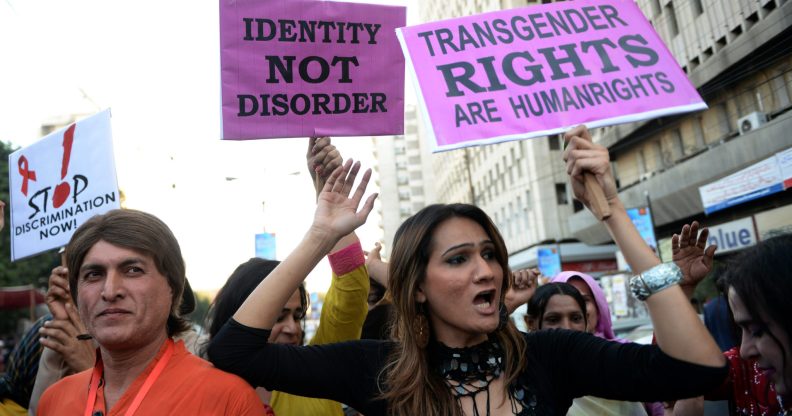This is the difference between gender and sexuality

Transgender activists in Pakistan (ASIF HASSAN/AFP/Getty)
Transgender activists in Pakistan (ASIF HASSAN/AFP/Getty)
Many assume gender identity and sexual orientation are linked, but the two concepts are different and it’s important to know why.
On a very basic level, gender identity is described as being more about who you are, and sexual orientation is defined as who you want to be with.
If someone is transgender, for example, some people assume that they must also be lesbian, gay or bisexual – but this is not the case.
However, gender and sexuality is (obviously) much more complex than this.
Related: What does gender-fluid mean? Courtney Act explains how gender-fluidity set her free
What is gender identity?
Gender identity is your own personal perception of yourself – and there are many different genders outside of male and female. And importantly, the gender with which someone identifies might not match the gender they were assigned at birth.
According to the Human Rights Campaign, gender identity is the “innermost concept of self as male, female, a blend of both or neither – how individuals perceive themselves and what they call themselves.”
Gender is complicated because different genders come with a host of societal expectations about behaviours and characteristics, which can have negative impacts on people.
Societal expectations of gender norms – or gender roles – often dictate who can and should do what.

A Pakistani transgender activist (ASIF HASSAN/AFP/Getty)
For instance, women have historically faced setbacks in the workplace, or fewer opportunities, purely because they are women and for no other reason.
Whereas from a traditional viewpoint, men are expected to make decisions, and naturally be authoritative when at work.
Gender also has legal implications. In the UK, anyone who wants to legally change the gender they were assigned with at birth has to apply for a Gender Recognition Certificate, but it is a lengthy and difficult process so not everyone chooses to do this.
To qualify for the certificate, people must have lived for two years in the gender they identify with and have a medical diagnosis of gender dysphoria.
Gender dysphoria is a condition where someone experiences distress because there is a mismatch between their gender identity and biological sex.
What is transitioning?
Transitioning describes the steps which a transgender person may take to live in the gender with which they identify.
The process is different for each person and may include medical intervention such as hormone therapy and surgeries, but not everyone wants or is able to have this.
It may involve transitioning socially, either by wearing different clothing, using names or pronouns or telling friends and family.
Gender expression is how someone expresses their gender identity externally, for example, through appearance – clothing, hair or make-up – or through their behaviour.

This is the difference between gender and sexuality (Manjunath Kiran/AFP/Getty)
Related: Portugal passes law to let trans people self-identify their legal gender
What is sexuality?
Sexual orientation is about who you are interested in being intimate with, in a relationship with, or interested in dating.
The Human Rights Campaign describes sexual orientation as “the inherent or immutable enduring emotional, romantic or sexual attraction to other people.”
Sexuality comes in many different forms and someone may be gay, straight, bisexual, pansexual or one of the many other sexual identities that exist.
Someone who is asexual does not experience sexual attraction.

(Getty)
Related: Here’s how laser hair removal is transforming the lives of trans people
Although gender identity and sexual orientation are often confused, it can be detrimental to assume the two are linked as it can lead to stereotyping and incorrect assumptions.
As a consequence, some people are against the grouping together of “lesbian, gay, bisexual and transgender” in the acronym LGBT.
The NHS’ Gender Identity Development Service acknowledges that there is “a degree of overlap” in the language used to think about sexual orientation and gender identity and the “shared histories of marginalisation, community and activism.”
However, it’s important to remember that marginalisation and abuse on the basis of gender identity – for example, transphobia – and sexual orientation – homophobia – are two separate issues.

